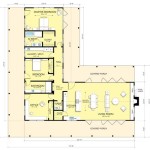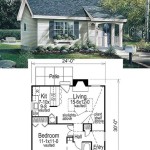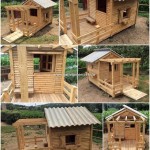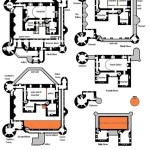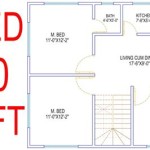Sears Roebuck House Plans refer to pre-designed blueprints and construction materials kits offered by the American retailer Sears, Roebuck and Company from 1908 to 1940. These plans allowed individuals and families to build their own homes at an affordable cost. For instance, the “Aladdin” model, one of the most popular Sears house plans, was a two-story, three-bedroom home that could be purchased for as little as $895.
The emergence of Sears Roebuck House Plans revolutionized home construction in the United States. They democratized homeownership by making it accessible to people of all income levels. Furthermore, the plans incorporated modern design elements and innovative construction techniques, shaping the architectural landscape of countless communities.
This article delves into the fascinating history of Sears Roebuck House Plans, exploring their impact on American architecture, homeownership, and the construction industry. We will also examine the reasons behind their decline and the enduring legacy they have left on the housing market.
Sears Roebuck House Plans played a pivotal role in shaping American architecture and homeownership.
- Affordable Housing
- Standardized Designs
- Mail-Order Convenience
- Innovative Construction
- Nationwide Availability
- Community Impact
- Architectural Legacy
- Democratized Homeownership
These plans left an enduring mark on the housing market.
Affordable Housing
One of the most significant impacts of Sears Roebuck House Plans was making homeownership more affordable for countless families. Prior to the introduction of these plans, building a home was a costly and time-consuming process, often reserved for the wealthy.
Sears Roebuck House Plans dramatically reduced the cost of home construction by offering pre-designed blueprints and materials kits at incredibly low prices. The company’s efficient manufacturing and distribution processes allowed them to mass-produce these plans, passing on the savings to customers.
Furthermore, Sears Roebuck offered flexible payment plans that made it easier for families to budget for their new homes. Buyers could choose from a variety of down payment options and monthly installment plans, reducing the financial burden associated with traditional mortgage loans.
As a result of these affordable prices and financing options, Sears Roebuck House Plans opened up the possibility of homeownership to a much broader segment of the population. Families with modest incomes could now afford to build their own homes, leading to a surge in home construction and the growth of new communities.
Standardized Designs
Sears Roebuck House Plans introduced a new era of standardized designs in home construction. Prior to their introduction, homes were typically custom-built, meaning that each house was unique in its design and layout.
Sears Roebuck, however, offered a catalog of pre-designed house plans that customers could choose from. These plans were standardized, meaning that they followed a specific set of design principles and construction methods.
- Consistency and Quality
Standardized designs ensured consistency and quality in home construction. The plans were carefully engineered to meet building codes and provide structural integrity. This resulted in homes that were well-built and durable.
- Variety and Customization
Despite being standardized, Sears Roebuck House Plans offered a wide variety of designs to choose from. Customers could select from a range of architectural styles, including Colonial, Victorian, Craftsman, and Bungalow.
Additionally, Sears Roebuck allowed customers to customize their plans by choosing different exterior finishes, floor plans, and optional features.
- Efficiency and Cost-Effectiveness
Standardized designs allowed Sears Roebuck to streamline the construction process, making it more efficient and cost-effective. The company could mass-produce materials and components, reducing the overall cost of building a home.
This efficiency and cost-effectiveness were passed on to customers in the form of lower prices.
- Architectural Legacy
Sears Roebuck House Plans had a significant impact on the architectural landscape of the United States. The standardized designs helped to popularize certain architectural styles and features.
For example, the Sears Roebuck “Aladdin” model is credited with helping to spread the Craftsman style across the country.
The standardized designs of Sears Roebuck House Plans not only made homeownership more affordable but also shaped the architectural character of countless communities.
Mail-Order Convenience
One of the most revolutionary aspects of Sears Roebuck House Plans was their mail-order convenience. Customers could order a complete house plan and materials kit from the Sears catalog, without ever having to visit a store or meet with a contractor.
The Sears catalog was widely distributed throughout the United States, reaching even remote rural areas. This allowed people living in all corners of the country to access affordable housing options.
To order a house plan, customers simply needed to fill out a form in the catalog and mail it to Sears. The company would then send the customer a complete set of blueprints and a materials list.
Customers could also order additional items from the Sears catalog, such as furniture, appliances, and tools. This one-stop shopping experience made it incredibly convenient for families to build their new homes.
Efficient Delivery
Sears Roebuck had a well-established logistics network that allowed them to deliver house plan materials quickly and efficiently. The company partnered with railroads and shipping companies to transport materials to customers all across the country.
In most cases, customers received their materials within a few weeks of placing their order. This allowed them to start building their homes without delay.
Clear Instructions and Support
Sears Roebuck recognized that many of their customers had little to no experience in home construction. To address this, the company provided detailed instructions and support materials with each house plan.
These materials included step-by-step instructions, diagrams, and troubleshooting tips. Sears Roebuck also offered a customer service hotline that customers could call for assistance.
Cost Savings
The mail-order convenience of Sears Roebuck House Plans also contributed to significant cost savings for customers.
By eliminating the need for middlemen, such as architects and contractors, Sears Roebuck was able to offer their plans and materials at lower prices.
Additionally, customers could save money on labor costs by building their own homes.
The mail-order convenience of Sears Roebuck House Plans revolutionized the home construction industry, making it more accessible and affordable for countless families.
Innovative Construction
Sears Roebuck House Plans not only made homeownership more affordable and convenient but also incorporated innovative construction techniques that were ahead of their time.
- Pre-Cut Materials
One of the most significant innovations was the use of pre-cut materials. Sears Roebuck provided customers with all of the lumber and other building materials pre-cut to the exact dimensions needed for their home.
This eliminated the need for customers to spend countless hours measuring and cutting materials on their own, saving them time and effort.
- Modular Construction
Sears Roebuck also pioneered the use of modular construction techniques. The company’s house plans were designed in such a way that the walls, floors, and other components could be assembled like puzzle pieces.
This modular approach made the construction process faster and more efficient, reducing the overall cost of building a home.
- Standardized Components
Sears Roebuck standardized many of the components used in their house plans. This allowed them to mass-produce these components in their own factories, ensuring consistent quality and reducing costs.
For example, Sears Roebuck produced its own windows, doors, and moldings, which were designed to fit perfectly into their house plans.
- New Materials and Techniques
Sears Roebuck was also at the forefront of adopting new materials and construction techniques. For example, the company was one of the first to use concrete foundations and asphalt roofing shingles in its house plans.
These new materials and techniques improved the durability and longevity of Sears Roebuck homes.
The innovative construction techniques used in Sears Roebuck House Plans not only made them more affordable and efficient to build but also resulted in homes that were well-built and durable.
Nationwide Availability
One of the key factors that contributed to the widespread popularity of Sears Roebuck House Plans was their nationwide availability. The Sears catalog was distributed to every corner of the United States, reaching even remote rural areas.
This meant that people living in all parts of the country could access affordable housing options, regardless of their location. Sears Roebuck also established a network of retail stores and sales agents across the country, making it easy for customers to obtain information and place orders.
Convenient Ordering Process
The Sears catalog made it incredibly convenient for customers to order house plans and materials. Customers could simply fill out a form in the catalog and mail it to Sears. The company would then send the customer a complete set of blueprints and a materials list.
Customers could also order additional items from the Sears catalog, such as furniture, appliances, and tools. This one-stop shopping experience made it incredibly easy for families to build their new homes.
Efficient Delivery
Sears Roebuck had a well-established logistics network that allowed them to deliver house plan materials quickly and efficiently. The company partnered with railroads and shipping companies to transport materials to customers all across the country.
In most cases, customers received their materials within a few weeks of placing their order. This allowed them to start building their homes without delay.
Community Impact
The widespread availability of Sears Roebuck House Plans had a significant impact on communities across the United States. The construction of new homes led to the growth of new neighborhoods and the expansion of existing ones.
Sears Roebuck homes also helped to improve the quality of life for many families. These homes were well-built and durable, providing families with safe and comfortable places to live.
Community Impact
The widespread availability of Sears Roebuck House Plans had a significant impact on communities across the United States. The construction of new homes led to the growth of new neighborhoods and the expansion of existing ones.
- Increased Homeownership
Sears Roebuck House Plans made homeownership possible for countless families who would not have been able to afford a custom-built home. This led to a significant increase in the rate of homeownership in the United States.
- Growth of New Neighborhoods
The construction of new Sears Roebuck homes led to the growth of new neighborhoods and the expansion of existing ones. These new neighborhoods often had their own schools, churches, and other community amenities.
- Improved Quality of Life
Sears Roebuck homes were well-built and durable, providing families with safe and comfortable places to live. These homes also featured modern amenities, such as indoor plumbing and electricity, which improved the quality of life for many families.
- Sense of Community
Sears Roebuck homes often shared similar architectural styles and features, which helped to create a sense of community among homeowners. Additionally, the fact that many families were building their homes at the same time fostered a sense of camaraderie and cooperation.
The community impact of Sears Roebuck House Plans was significant and long-lasting. These homes helped to shape the physical and social landscape of communities across the United States.
Architectural Legacy
The architectural legacy of Sears Roebuck House Plans is vast and enduring. These homes have had a significant impact on the architectural landscape of the United States, shaping the character of countless communities.
- Standardized Designs
One of the most significant aspects of Sears Roebuck House Plans was their standardized designs. The company offered a catalog of pre-designed house plans that customers could choose from. These plans were carefully engineered to meet building codes and provide structural integrity.
The standardized designs of Sears Roebuck homes helped to popularize certain architectural styles and features. For example, the Sears Roebuck “Aladdin” model is credited with helping to spread the Craftsman style across the country.
- Mass Production
Sears Roebuck’s mass production techniques allowed them to produce house plans and materials at a low cost. This made it possible for families of all income levels to build their own homes.
The mass production of Sears Roebuck homes also helped to create a sense of uniformity in many neighborhoods. This uniformity can be seen in the rows of identical or similar homes that are found in many towns and cities across the United States.
- Influence on Modern Architecture
The standardized designs and mass production techniques used by Sears Roebuck had a significant influence on the development of modern architecture. The company’s emphasis on efficiency and affordability helped to shape the design principles of modernism.
Many modern architects, such as Frank Lloyd Wright and Le Corbusier, were influenced by the work of Sears Roebuck. These architects sought to create affordable, well-designed homes that could be mass-produced.
- Preservation and Restoration
Sears Roebuck homes are an important part of the architectural heritage of the United States. Many of these homes have been preserved and restored, providing a glimpse into the past and the way that people lived in the early 20th century.
There are a number of organizations dedicated to the preservation of Sears Roebuck homes. These organizations work to identify, document, and restore these homes, ensuring that they will continue to be enjoyed by future generations.
The architectural legacy of Sears Roebuck House Plans is a complex and fascinating one. These homes have had a profound impact on the way that we live and build, and they continue to be admired and appreciated today.
Democratized Homeownership
One of the most significant impacts of Sears Roebuck House Plans was the democratization of homeownership in the United States. Prior to the introduction of these plans, homeownership was largely reserved for the wealthy.
Sears Roebuck House Plans made homeownership possible for families of all income levels. The affordability of these plans, combined with the convenience of mail-order ordering and the availability of pre-cut materials, made it possible for families to build their own homes without the need for expensive architects or contractors.
The democratization of homeownership had a profound impact on American society. It allowed families to build equity, invest in their communities, and achieve a sense of financial security. Homeownership also provided families with a sense of pride and accomplishment, and it helped to create a more stable and prosperous society.
The legacy of Sears Roebuck House Plans continues to this day. These homes are still admired for their affordability, durability, and architectural charm. They are a reminder of the important role that Sears Roebuck played in making homeownership a reality for countless American families.
In addition to the affordability and convenience of Sears Roebuck House Plans, there were a number of other factors that contributed to the democratization of homeownership in the United States during this period.










Related Posts

